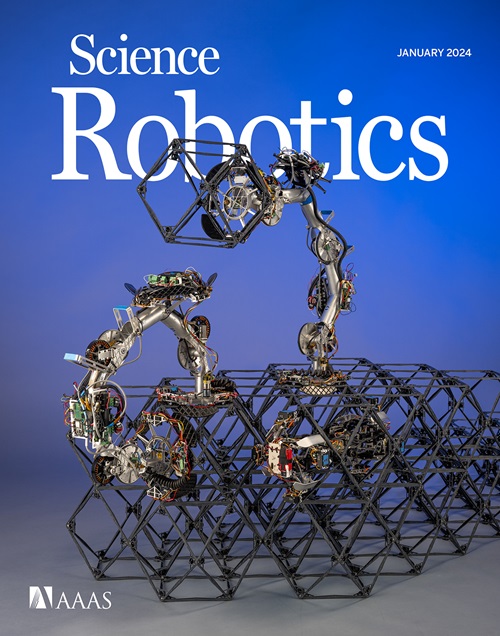Virtual elasto-plastic robot compliance to active environments
IF 27.5
1区 计算机科学
Q1 ROBOTICS
Science Robotics
Pub Date : 2025-02-26
引用次数: 0
Abstract
Humans exhibit a particular compliant behavior in interactions with their environment. Facilitated by fast physical reasoning, humans are able to rapidly alter their compliance, enhancing robustness and safety in active environments. Transferring these capabilities to robotics is of utmost importance particularly as major space agencies begin investigating the potential of cooperative robotic teams in space. In this scenario, robots in orbit or on planetary surfaces are meant to support astronauts in exploration, maintenance, and habitat building to reduce costs and risks of space missions. A major challenge for interactive robot teams is establishing the capability to act in and interact with dynamic environments. Analogous to humans, the robot should be not only particularly compliant in case of unexpected collisions with other systems but also able to cooperatively handle objects requiring accurate pose estimation and fast trajectory planning. Here, we show that these challenges can be attenuated through an enhancement of active robot compliance introducing a virtual plastic first-order impedance component. We present how elasto-plastic compliance can be realized via energy-based detection of active environments and how evasive motions can be enabled through adaptive plastic compliance. Two space teleoperation experiments using different robotic assets confirm the potential of the method to enhance robustness in interaction with articulated objects and facilitate robot cooperation. An experiment in a health care facility presents how the same method analogously solidifies robotic interactions in human-robot shared environments by giving the robot a subordinate role.
虚拟弹塑性机器人对活动环境的顺应性
人类在与环境的互动中表现出一种特殊的顺从行为。在快速物理推理的推动下,人类能够迅速改变他们的依从性,增强活跃环境中的稳健性和安全性。将这些能力转移到机器人技术是极其重要的,特别是在主要空间机构开始研究空间合作机器人团队的潜力之际。在这种情况下,轨道或行星表面上的机器人将支持宇航员进行探索、维护和栖息地建设,以降低太空任务的成本和风险。交互式机器人团队面临的一个主要挑战是建立在动态环境中行动并与之交互的能力。与人类类似,机器人不仅要在与其他系统发生意外碰撞时具有特别的顺应性,而且要能够协同处理需要精确姿态估计和快速轨迹规划的物体。在这里,我们展示了这些挑战可以通过引入虚拟塑料一阶阻抗组件来增强主动机器人的顺应性来减弱。我们介绍了如何通过基于能量的主动环境检测实现弹塑性顺应性,以及如何通过自适应塑性顺应性实现规避运动。使用不同机器人资产的两个空间遥操作实验证实了该方法在增强与铰接物体交互的鲁棒性和促进机器人合作方面的潜力。在医疗机构的一项实验展示了同样的方法如何通过赋予机器人从属角色来类似地巩固人机共享环境中的机器人交互。
本文章由计算机程序翻译,如有差异,请以英文原文为准。
求助全文
约1分钟内获得全文
求助全文
来源期刊

Science Robotics
Mathematics-Control and Optimization
CiteScore
30.60
自引率
2.80%
发文量
83
期刊介绍:
Science Robotics publishes original, peer-reviewed, science- or engineering-based research articles that advance the field of robotics. The journal also features editor-commissioned Reviews. An international team of academic editors holds Science Robotics articles to the same high-quality standard that is the hallmark of the Science family of journals.
Sub-topics include: actuators, advanced materials, artificial Intelligence, autonomous vehicles, bio-inspired design, exoskeletons, fabrication, field robotics, human-robot interaction, humanoids, industrial robotics, kinematics, machine learning, material science, medical technology, motion planning and control, micro- and nano-robotics, multi-robot control, sensors, service robotics, social and ethical issues, soft robotics, and space, planetary and undersea exploration.
 求助内容:
求助内容: 应助结果提醒方式:
应助结果提醒方式:


